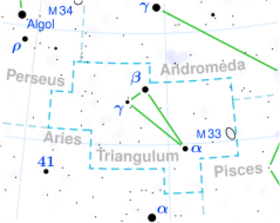Astronomy:13 Trianguli
| Observation data Equinox J2000.0]] (ICRS) | |
|---|---|
| Constellation | Triangulum |
| Right ascension | 02h 28m 48.49449s[1] |
| Declination | +29° 55′ 54.3286″[1] |
| Apparent magnitude (V) | 5.89[2] |
| Characteristics | |
| Spectral type | G0 V[2] |
| U−B color index | +0.01[3] |
| B−V color index | +0.591±0.014[2] |
| Astrometry | |
| Radial velocity (Rv) | +40.8[4] km/s |
| Proper motion (μ) | RA: –66.071[1] mas/yr Dec.: +71.499[1] mas/yr |
| Parallax (π) | 31.7031 ± 0.1014[1] mas |
| Distance | 102.9 ± 0.3 ly (31.5 ± 0.1 pc) |
| Absolute magnitude (MV) | 3.45[5] |
| Details | |
| Mass | 1.10±0.03[5] M☉ |
| Radius | 1.86±0.03[1] R☉ |
| Luminosity | 3.72[5] L☉ |
| Temperature | 5,846[5] K |
| Metallicity [Fe/H] | −0.24[6] dex |
| Rotational velocity (v sin i) | 3[7] km/s |
| Age | 6.45[5] Gyr |
| Other designations | |
| Database references | |
| SIMBAD | data |
13 Trianguli is the Flamsteed designation for a star in the northern constellation of Triangulum. It has an apparent visual magnitude of 5.89,[2] so according to the Bortle scale it is faintly visible from dark suburban skies. The star is located at a distance of 103 light years from the Sun based on parallax measurements,[1] and is drifting further away with a radial velocity of +41 km/s.[4] It made a close approach to the Sun some 665,000 years ago at an estimated separation of 34.3 light-years.[2]
A stellar classification of G0 V[2] indicates this is a main sequence star that is generating energy by fusing hydrogen into helium at its core. It has about 110% of the Sun's mass, 186% of the Sun's radius, and shines with 3.72 times the luminosity of the Sun. The stellar atmosphere has an effective temperature of 5,846 K,[5] giving it the yellow hue of a G-type star.[8] It appears to be older than the Sun, with an estimated age of 6.45 billion years.[5]
In 1994, an astrometric companion was reported at an angular separation of 0.020″. However, follow-up observations reported in 2005 not only failed to recover this object but also returned a null result on a search for planetary companions.[9] The star has been examined for an infrared excess that could indicate the presence of an orbiting debris disk, but no such excess was found.[6]
References
- ↑ 1.0 1.1 1.2 1.3 1.4 1.5 1.6 Brown, A. G. A. (August 2018). "Gaia Data Release 2: Summary of the contents and survey properties". Astronomy & Astrophysics 616: A1. doi:10.1051/0004-6361/201833051. Bibcode: 2018A&A...616A...1G. Gaia DR2 record for this source at VizieR.
- ↑ 2.0 2.1 2.2 2.3 2.4 2.5 Anderson, E.; Francis, Ch. (2012), "XHIP: An extended hipparcos compilation", Astronomy Letters 38 (5): 331, doi:10.1134/S1063773712050015, Bibcode: 2012AstL...38..331A.
- ↑ 3.0 3.1 "13 Tri -- Star", SIMBAD Astronomical Database (Centre de Données astronomiques de Strasbourg), http://simbad.u-strasbg.fr/simbad/sim-id?Ident=13+Trianguli, retrieved 2013-10-13.
- ↑ 4.0 4.1 Nordström, B. et al. (May 2004), "The Geneva-Copenhagen survey of the Solar neighbourhood. Ages, metallicities, and kinematic properties of ˜14,000 F and G dwarfs", Astronomy and Astrophysics 418 (3): 989–1019, doi:10.1051/0004-6361:20035959, Bibcode: 2004A&A...418..989N.
- ↑ 5.0 5.1 5.2 5.3 5.4 5.5 5.6 Takeda, Yoichi (April 2007), "Fundamental Parameters and Elemental Abundances of 160 F-G-K Stars Based on OAO Spectrum Database", Publications of the Astronomical Society of Japan 59 (2): 335–356, doi:10.1093/pasj/59.2.335, Bibcode: 2007PASJ...59..335T.
- ↑ 6.0 6.1 Maldonado, J. et al. (May 2012). "Metallicity of solar-type stars with debris discs and planets". Astronomy & Astrophysics 541: A40. doi:10.1051/0004-6361/201218800. Bibcode: 2012A&A...541A..40M.
- ↑ Takeda, Yoichi et al. (February 2005), "High-Dispersion Spectra Collection of Nearby F--K Stars at Okayama Astrophysical Observatory: A Basis for Spectroscopic Abundance Standards", Publications of the Astronomical Society of Japan 57 (1): 13–25, doi:10.1093/pasj/57.1.13, Bibcode: 2005PASJ...57...13T.
- ↑ "The Colour of Stars", Australia Telescope, Outreach and Education (Commonwealth Scientific and Industrial Research Organisation), December 21, 2004, archived from the original on March 18, 2012, https://web.archive.org/web/20120318151427/http://outreach.atnf.csiro.au/education/senior/astrophysics/photometry_colour.html, retrieved 2012-01-16.
- ↑ van Belle, G. T. et al. (May 2008). "The Palomar Testbed Interferometer Calibrator Catalog". The Astrophysical Journal Supplement Series 176 (1): 276–292. doi:10.1086/526548. Bibcode: 2008ApJS..176..276V.
Coordinates: ![]() 02h 28m 48.49s, +29° 55′ 54.33″
02h 28m 48.49s, +29° 55′ 54.33″
 |


